Laser Tattoo Removal Treatments
Based within a medical practice Park Ridge Skin now offers laser tattoo removal.
Our clinic is able to treat all tattoo colours on any skin type. Tattoo lasers remove tattoos by breaking up the pigment colours with a high-intensity light beam.
WHAT TO EXPECT DURING TREATMENT
During a laser tattoo removal procedure, the practitioner guides a laser over the area of the tattoo. Unlike a laser pointer that produces a continuous beam of light, tattoo removal lasers produce pulses of light energy.
Each pulse of energy penetrates the skin and is absorbed by the tattoo ink. As the tattoo ink particles absorb the energy, they heat up and then shatter into tiny fragments. Then, over the weeks following treatment, the body’s immune system flushes the tattoo ink particles away from the location, lightening the appearance of the tattoo. Each laser treatment breaks down more and more of the tattoo ink until none remains.
Tattoo removal is not an instant fix – it’s usually a several-month commitment for patients. Most tattoos require between 5 and 10 treatments to achieve complete removal, and the treatments must be spaced at least 6 weeks apart. Patients often ask why tattoo removal requires so many treatments and why they have to wait between treatments. As a practitioner, it’s important to know the answers to these questions to provide an informative patient consultation.
Laser tattoo removal requires multiple treatments because not all of the tattoo ink can be shattered in one treatment session. When a tattoo is applied, the ink is injected at different depths within the dermis. As the laser light is applied to the skin, the shallowest layers of ink in the dermis absorb the energy and shatter, but the deeper layers may not have been affected. Only once the body flushes away the top layers of ink can the deeper layers being treated. In effect, every successive tattoo removal treatment affects deeper and deeper layers of ink until none remains.
Patients need to wait between treatments because it takes time for the body to flush away the shattered tattoo ink from the location of the tattoo. The process of flushing away the ink involves immune system phagocytic cells gradually moving the ink particles to the lymph nodes, where the pigments remain. Because the body can only flush away the ink at a certain speed, it’s beneficial to wait as long as possible between treatments to see maximum fading from each session. Also, the waiting period allows any scabs or blisters to heal, minimizing the possibility of over-treating the area and causing unwanted side effects.
AFTERCARE FOR YOUR LASER TREATMENT
How should I treat the tattoo after laser?
When you leave our clinic after your treatment, your tattoo will be covered with a soothing gel and a sterile dressing. In some cases, we may simply apply a gel without a dressing. After this, you should;
Ice, Ice, Ice the area as soon as possible after treatment and repeat this several times in the ensuing 48 hours. The more heat you can take out of the area following treatment, the better your tattoo will feel, look and respond in the following days. You can apply covered ice-packs directly over the dressing and/or after it has been removed, alternating at 15 minute intervals. If your tattoo is on your arm or leg, also try to elevate the tattoo whilst you are icing it. The more you do this in the first 24 hours, the less swelling and discomfort you will experience.
Remove the dressing after a maximum of a few hours only, removing it either after the gel escapes, before you have a shower, or before you go to bed – whichever happens first.
After removing the dressing, gently clean the area with water and pat it dry. Do not use soaps, body lotions or the like on your tattoo whilst ever it is still healing. Apply Aloe Vera gel regularly (twice per day) for at least 48 hours immediately after treatment. This will soothe the area whilst letting it breathe and help to prevent any itchiness. Keep your Aloe Vera gel in the fridge to provide extra soothing. There is no need to re-apply a dressing to your tattoo after removing the original dressing. If your tattoo is on a part of your body that rubs on your clothes or shoes and is likely to get aggravated, then you may apply another dressing. If you choose to do so, apply Aloe Vera Gel under the dressing and remove it regularly, in line with the guidelines above.
Rest and elevation of your tattoo in the first 24 hours following treatment will assist in the healing process and will help to minimise any localised discomfort and swelling. You may take over-the-counter pain relief medications like paracetamol (as directed on the packaging) if you experience any localised discomfort. Try and avoid the use of aspirin or ibuprofen, as these can increase the risk of bleeding or bruising.
You will experience some very light scabbing on your tattoo in the days following treatment. These micro scabs (in the shape of squares) are from the fractional laser that we used on your tattoo at the end of your treatment to assist the healing process. These will feel like sandpaper and may remain for up to 2 weeks on areas of low circulation. Do not pick these. Allow them to fall off at their own speed and your skin will be nice and smooth again once they fall off.
You may experience some light oozing from your tattoo in the days after treatment. This is common, especially in the case of large tattoos, and is the result of the swelling trying to escape. This oozing will escape through the tiny holes that the fractional laser has created and will prevent blistering and assist in the healing process. Simply dab dry any oozing and cover it with a bandage if necessary, to protect your clothes.
Once the skin has fully healed and any crusting or scabbing has disappeared, we recommend the regular application of a moisturiser such as Vitamin E. This will help to improve skin hydration, reduce potential itchiness and assist in the ongoing healing and soothing process.
It is common during the healing process to develop an itching sensation on your tattoo. This is a normal part of the healing process as your body starts to get rid of the ink particles and can also indicate dehydration. If this occurs, try not to scratch the area, apply a moisturising cream such as Vitamin E cream, and drink plenty of fluids. In extreme cases, you may apply a 1% Hydrocortisone ointment (such as Sigmacort) and/or take oral anti-histamines (such as Telfast).
You may apply make-up to the tattoo once any broken skin has healed.
What do I do if I get blisters after my laser treatment?
It is possible that you may experience some blistering after your laser treatment. Do not be alarmed by this. This bodily reaction is a normal part of the healing process and often occurs on very large tattoos or on areas of low circulation, such as fingers and ankles. Blisters are readily treatable and with the right aftercare, will heal perfectly and leave the skin intact.
In the event that blisters form:
Do not puncture them. Continue to apply ice to them for up to 48 hours after treatment. This will reduce and help to prevent any associated discomfort, and in some cases, will enable them to subside (re-absorb) completely.
If the blisters pop (on their own or accidently), apply an antibacterial ointment or liquid several times a day and cover them with a dressing or bandage. Continue this care until at least 48 hours after the blisters have burst.
If there is any crusting, scabbing or oozing from the blisters:
Do not pick at them or allow the skin to become scraped, as this may result in infection and scarring. Avoid shaving the area until it is completely healed.
Apply an antibacterial ointment or liquid several times a day and cover it with a dressing or bandage.
Repeat this each day until any crusting, scabbing or oozing is gone.
It is very rare but possible that your tattoo may become infected following blisters. In the rare event that the tattoo looks infected: (i.e. you develop a temperature over 38°C or increasing pain, and/or there is honey coloured oozing or increasing redness running away from the area), contact us immediately or visit your local doctor or medical centre.
What should I avoid after laser tattoo treatment?
Avoid excessive heat in the skin (baths, saunas, spas, heated yoga etc.) for at least 48 hours after treatment. This also relates to your work environment, where you may be exposed to hot conditions in a commercial kitchen, bakery or similar. Try to keep your healing tattoo as protected from heat as possible, so as to minimise the chance of blisters. It can take up to 2 days for all of the heat to dissipate from your body after a laser treatment, particularly on large tattoos.
Avoid soaking your tattoo in baths, saunas, spas, pools and the ocean whilst there is any scabbing on your tattoo. You may swim or surf for short periods as long as you avoid sun exposure, gently pat the tattoo dry afterwards, and adhere to any other relevant instructions within this guide.
You may shower on the day of your treatment but try to avoid letting very hot or high pressure water hit the tattoo. In the first 48 hours after treatment, re-ice your tattoo after any showering and re-apply the Aloe Vera gel.
Avoid direct or prolonged sun exposure at all times during the healing and ongoing treatment process, but particularly in the first 4 weeks after a treatment. Recovering from laser treatment is akin to recovering from sunburn, so to get sunburned on existing sunburn wouldn’t be a good idea. Not only does sun exposure heighten the chance of blistering, but it also heightens the chance of abnormal pigmentation (hyper-pigmentation or hypo-pigmentation) developing. This also applies to tanning beds, spray tans, tanning injections and any other form of artificial tanning. In the event that you cannot avoid direct and prolonged sun exposure after treatment, wear protective clothing over your tattoo or apply an SPF50+ sunscreen at all times. The more pale your tattoo skin is at each treatment, the more effective each treatment will be.
Avoid excessive exercise in the first 48 hours after treatment, to allow the heat to escape from your body and to minimise the chance of blistering and any swelling. Gentle exercise is fine, as long as you ice your tattoo again after exercise. The larger your tattoo, the more important this is.
Avoid injury and abrasion to your tattoo at all times before and after treatment. The more you care for your skin throughout the removal process, the better your results will be.

